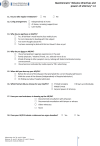Advance Directives and Powers of Attorney in Intensive Care Patients
- PMID: 28625275
- PMCID: PMC5478788
- DOI: 10.3238/arztebl.2017.0363
Advance Directives and Powers of Attorney in Intensive Care Patients
Abstract
Background: Advance directives and powers of attorney are increasingly common, yet data on their use in clinical situations remain sparse.
Methods: In this single center cross-sectional study, we collected data by questionnaire from 1004 intensive care patients in a university hospital. The frequencies of advance directives and powers of attorney were determined, and the factors affecting them were studied with multivariate logistic regression analysis.
Results: Usable data were obtained from 998 patients. 51.3% stated that they had prepared a document of at least one of these two kinds. Among them, 39.6% stated that they had given the relevant document(s) to the hospital, yet such documents were present in the patient's hospital record for only 23%. 508 patients stated their reasons for preparing an advance directive or a power of attorney: the most common reason (48%) was the fear of being at other people's mercy, of the lack of self-determination, or of medical overtreatment. The most important factors associated with a patient's statement that he/she had prepared such a document were advanced age (advance directive: 1.022 [1.009; 1.036], p = 0.001; power of attorney: 1.027 [1.014; 1.040], p<0.001) and elective admission to the hospital (advance directive: 1.622 [1.138; 2.311], p<0.007; power of attorney: 1.459 [1.049; 2.030], p = 0.025). 39.8% of the advance directives and 44.1% of the powers of attorney that were present in the hospital records were poorly interpretable because of the incomplete filling-out of preprinted forms. Half of the patients who did not have such a document had already thought of preparing one, but had not yet done so.
Conclusion: For patients hospitalized in intensive care units, there should be early discussion about the presence or absence of documents of these kinds and early evaluation of the patient's concrete wishes in critical situations. Future studies are needed to determine how best to assure that these documents will be correctly prepared and then given over to hospital staff so that they can take their place in the patient's record.
Figures



References
-
- May AT, Brokmann JC. Medizinische und medizinethische Grundlagen der Vorsorgemöglichkeiten. Anaesthesist. 2010;59:118–125. - PubMed
-
- Janssens U, Burchardi H, Duttge G, et al. Therapiezieländerung und Therapiebegrenzung in der Intensivmedizin. Med Klin Intensivmed Notfmed. 2013;108:47–52. - PubMed
-
- Ulsenheimer K. Neue Regelung der Patientenverfügung. Welche Konsequenzen ergeben sich für die Praxis? Anaesthesist. 2010;59:111–117. - PubMed
-
- Allensbach IfD. Deutlicher Anstieg bei Patientenverfügungen Allensbach Kurzbericht. www.ifd-allensbach.de/studien-und-bericht (last accessed on 24 April 2017)
MeSH terms
LinkOut - more resources
Full Text Sources
Other Literature Sources
Medical

